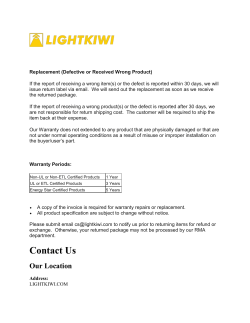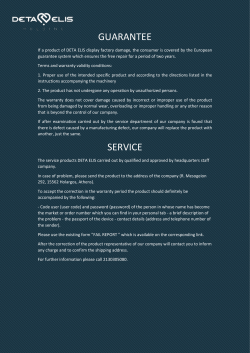
File - D. Landon Allen, MPH, MBA
The Cost of Quality and Its Components by Daniel Landon Allen The need to control the quality of business systems has existed since the inception of businesses themselves, though it was not until 1956 when Armand Feigenbaum first addressed the costs associated with the process.1 Though the definition of the cost of quality varies among different entities, fundamentally, it encompasses any cost that a firm incurs in order to insure that its products are as defect free as possible, or that is incurred as a result of correcting a defective good either before or after it is sold to a consumer. It is essentially the quantifying of the total cost of quality-related efforts and deficiencies. If this definition of the cost of quality is to be utilized, then an understanding of the three main categories of these types of costs is needed. These groupings include prevention, appraisal, and failure costs (with the latter having two subcategories; internal and external).2 In this report, the theory of the cost of quality as it applies to modern businesses will be presented with specific attention given to the three categories of costs dealing with the assurance of quality by a firm. The first category of quality cost (and oftentimes most cost effective for the firm) deals with the prevention of defects. This grouping is perhaps the broadest and contains the sum of all costs associated with the identification and eradication of potential defects.3 Specifically, costs from the implementation of quality control engineering, employee quality training and workforce development, quality-associated maintenance of tools and machinery, product-design verification, investments in quality-related information systems, and quality systems development and management (as well as others) fit into this category.4 It should be noted that although these costs usually occur near the beginning of the product life cycle, many of them persist throughout it. There is, to some extent, a tradeoff between this category of quality cost and the remaining two (appraisal and failure). Firms who heavily invest in systems designed to minimize defects in production tend to need fewer inspections and have a lower failure frequency. The next quality cost is incurred when a firm spends resources inspecting and testing products to ensure they are acceptable. The goal in the case of these appraisal costs is to sample a sufficient number of products in order to statistically prove that a certain standard of quality is being met. Some of the various types of activities included in this category are inspection of supply materials received, quality inspection setup costs, inspection and testing during the manufacturing process, internal and external audits, laboratory acceptance inspections, outside endorsements, and field testing.5 In many cases, the processes in this category lead to the early detection of system inadequacies. Firms are then able to stop 1 Feigenbaum, Armand V. (November-December 1956), "Total Quality Control", Harvard Business Review 34 (6). Jacobs, F. Robert., Richard B. Chase, and Nicholas J. Aquilano. Operations and Supply Management. Boston: McGraw-Hill, 2009. Print. 3 Jacobs, F. Robert., Richard B. Chase, and Nicholas J. Aquilano. Operations and Supply Management. Boston: McGraw-Hill, 2009. Print. 4 Feigenbaum, Armand V. (November-December 1956), "Total Quality Control", Harvard Business Review 34 (6). 5 Feigenbaum, Armand V. (November-December 1956), "Total Quality Control", Harvard Business Review 34 (6). 2 or reroute production until the problems can be fixed, thus minimizing the number of defective products made as well as the losses associated with them (which are described in more detail in the next paragraph). The third major category of quality cost (and oftentimes, most expensive to the firm) deals with expenditures associated with a defect (or its correction). For the most part, these can occur in one of two subcategories associated with the point in the production system where the defect in quality is discovered. The first (and between the two, least damaging to the firm) occurs within the production process before the product has been delivered to customers. These internal failures result in costs associated with either the scraping, spoilage, or reworking of the good in order to avoid delivery of a defective product.6 The goal in this situation is to reclaim as much of the original investment in the product as possible (in terms of raw materials or labor time) and thereby minimize losses to the firm. In general, the earlier the defect is caught, the higher the likelihood of reducing losses to their minimum. In some instances, there may also be costs associated with production down time.7 This may occur, for example, in situations where the defective product is part of a continuous flow system or if the defect is due to a problem with a certain process or machine which must be repaired. The second subcategory of failure costs deals with those that occur outside the firm. In these external failure cases, the product has already been delivered to the customer and the firm must incur the costs associated with correcting the failure. This may include replacing or repairing the product in accordance with the product’s warranty or paying for any damages associated with the product’s failure (in other words, costs associated with product liability). In addition, costs may be incurred as a part of the recall process if the defect is serious enough to warrant the return of all goods. More enduring and oftentimes more detrimental to the firm in all of these cases are the costs associated with the loss of future revenues that come from damaged reputation and lost sales. In the worst cases, a widespread product defect can hurt business for years (or even decades).8 Though the costs of quality are by nature varied and diverse, they typically fall into one of three categories. Costs associated with the avoidance of defects whether they occur before or during the manufacturing process are labeled prevention quality costs. Those that occur as a result of detecting defects or testing for quality standard conformity are labeled appraisal costs. Finally, costs associated with the repair of defects which occur either internally or externally with regard to the firm are labeled failure costs. For the modern day firm, the prevention costs will serve as the foundation for success in the quest to provide the best quality to customers; no other category stands to create as big a difference for the money invested. As markets and industries mature, firms will find it necessary to utilize this idea in order to remain competitive in the face of lower prices and higher quality from competitors. 6 Feigenbaum, Armand V. (November-December 1956), "Total Quality Control", Harvard Business Review 34 (6). Jacobs, F. Robert., Richard B. Chase, and Nicholas J. Aquilano. Operations and Supply Management. Boston: McGraw-Hill, 2009. Print. 8 Feigenbaum, Armand V. (1991), Total Quality Control (3 ed.), New York, New York: McGraw-Hill, p. 111. 7
© Copyright 2025



















